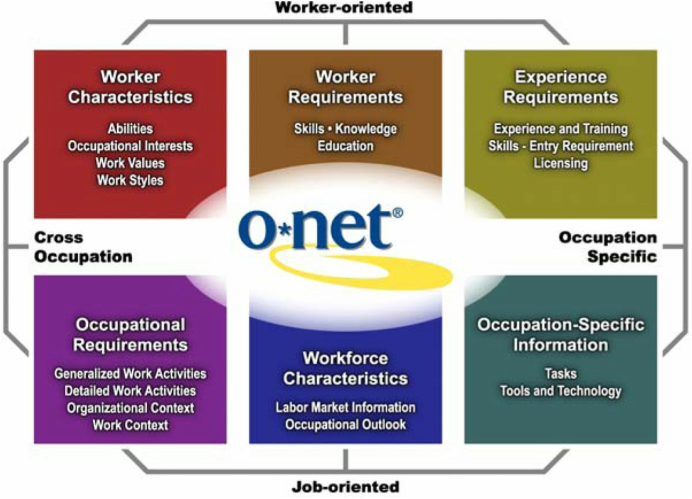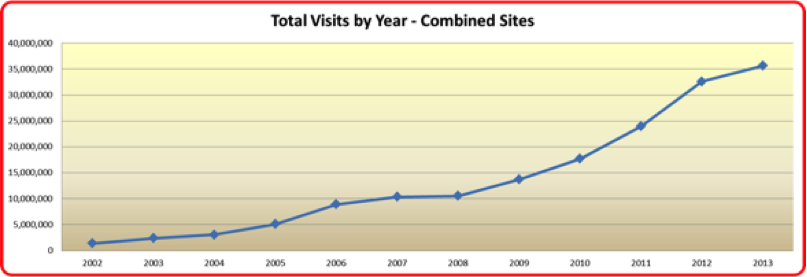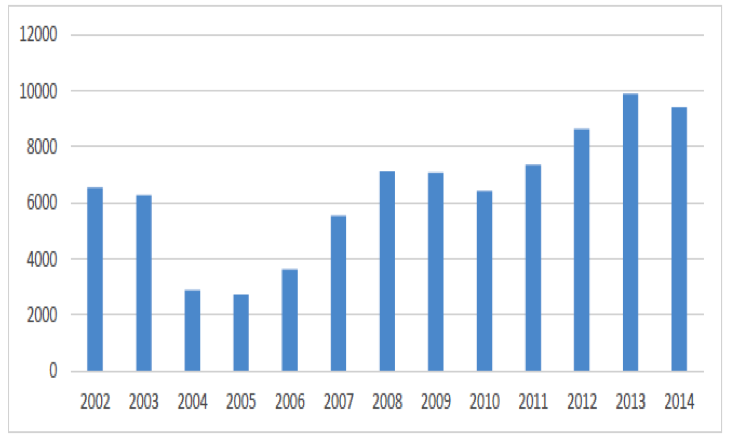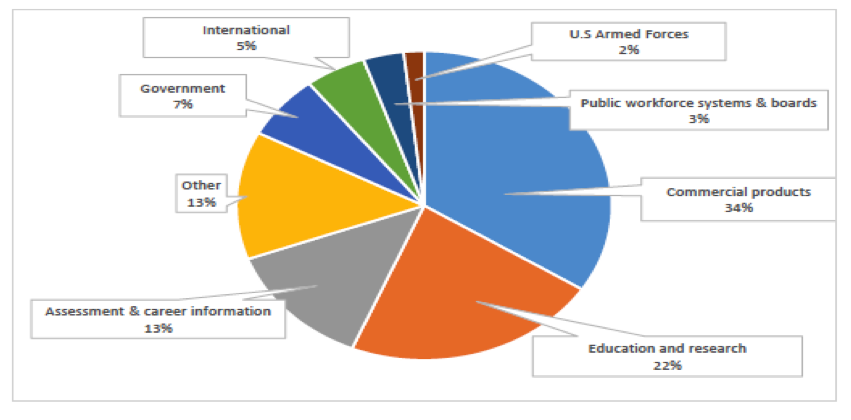|
The skills market encompasses the entire economy. However, I feel like there are so many people who are not aware of the Federal sources in the skills arena. So, this blog will highlight the primary source from the Federal government, O*NET - The Occupation Information Network. Fig. 1: O*NET Content Model What Is O*NET? O*NET is a (data collection) program that populates and maintains a current database of the detailed characteristics of workers, occupations, and skills. Currently, O*NET contains information on 974 detailed occupations, which are gathered from a sample of national surveys of businesses and workers. For each occupation, O*NET collects data on 250 occupational descriptors. O*NET is intended to be a definitive source for persistent occupation data, i.e. stable occupations that have been (and will continue to be) in existence over the medium term. O*NET superseded the U.S. Department of Labor’s (DOL’s) Dictionary of Occupational Titles (DOT) and provides additional occupational requirements not available in the DOT. The DOT is no longer supported by DOL. O*NET uses an occupational taxonomy, the O*NET-SOC, which is based on the 2010 version of the Standard Occupational Classification (SOC) mandated by Office of Management and Budget (OMB) for use by all federal agencies collecting occupational and labor market information (LMI). O*NET is the bedrock of occupational data. It offers a stable foundation that contains information on jobs and skills that are not fleeting. In a phrase, it is the gold standard of data on occupational skills. Why Use Sampling and Surveys? The primary reason O*NET currently uses sampling and surveys is that these are the best techniques for maximizing the quality, objectivity, utility, and integrity of information prior to dissemination. O*NET uses the OMB Information Quality Guidelines for all Federal statistical information, which defines objectivity as a measure of whether disseminated information is: 1. Accurate 2. Reliable 3. Unbiased 4. Presented/disseminated in an accurate, clear, complete, and unbiased manner 5. Subject to extensive review and or quality control What Are Other Foundational Principles of O*NET? O*NET is designed to be:
Why Does O*NET Only Contain Survey-based Data? Using survey-based data enables O*NET to have comprehensive coverage, be very representative, enable the data to be validated and cleaned relatively easily, enable the statistical calculation of margin of variance or error, and to meet the OMB data collection requirements. What About Other Types of Data? There are two other primary types of data that could be included in the O*NET data set — transactional data and crowdsourced data. Transactional data tends to be privately owned and have a potential for response bias. Currently, occupational and industry coverage is limited, e.g. in certain industries, online job postings are the norm and in others, it is not. Also, the use of online job postings vary with the size of the firm — smaller employers are less likely to post job openings online. Finally, many postings don’t specify the information desired by O*NET curators. Crowdsourced data tends to the least representative of the set, has the greatest potential for response bias, can be very difficult to validate independently and can easily capture leading or emerging variations. Both transactional and crowdsourced data would require significant investments in curation and management for them to satisfy the OMB Information Quality Guidelines and the O*NET Foundational Principles, which are intended to fix the problems with the DOT. How Is O*NET Used? O*NET is the common language and framework that facilitates communication about industry skill needs among business, education, and the workforce investment system. The O*NET data is used to:
The O*NET database and companion O*NET Career Exploration Tools are also used by many private companies and public organizations to tailor applications to their needs and those of their customers. How Do I Access O*NET Data? The O*NET database is provided free of charge to the public through O*NET OnLine. O*NET Data is also available through the My Next Move, and My Next Move for Veterans websites; through the O*NET Web Services application programming interface (API); or by downloading the database, particularly by developers who provide applications targeted to specific communities or audiences. How Does O*NET Collect Its Data? The O*NET data set gets updated once a year. O*NET uses a 2-stage sample — first businesses in industries that employ the type of worker are sampled and contacted — then when it is confirmed that they employ those workers and will participate — a random sample of their workers in the occupation receive the O*NET survey form and respond directly. When necessary, this method may be supplemented with a sample selected from additional sources, such as professional and trade association membership lists, resulting in a dual-frame approach. An alternative method, based on sampling from lists of identified occupation experts, is used for occupations for which the primary method is inefficient. This method is reserved for selected occupations, such as those with small employment scattered among many industries and those for which no employment data currently exist on which to base a sample, such as new and emerging occupations. At its current funding level, O*NET updates slightly more than 100 occupations per year with new survey data. What Are The Survey Response Rates? Currently, more than 144,000 establishments and 182,000 employees have responded to the survey request, resulting in an establishment response rate of 76% and an employee response rate of 65%, which compare favorably to other establishment surveys. O*NET Usage Statistics Current O*NET Usage Statistics During 2014, the O*NET websites (O*NET OnLine, My Next Move, My Next Move for Veterans, Mi Proximo Paso) averaged over 4 million visits per month. Fig. 2 shows the total site visits by year from 2002 to 2013. Fig. 2: Total Site Visits for O*NET web properties There is some pattern of seasonality that appears to follow the school calendar. Peak months with over 5 million visits in 2014 were: April, September, and October. The O*NET database has been downloaded 83,573 times from 2002 to 2014. Fig. 3 shows the database downloads in each year. Fig. 3: O*NET Database Downloads, 2002 - 2014 O*NET Web Services and APIs were introduced in 2012 and their usage is steadily increasing through 2014. At the close of 2014, there were 343 total registrants for O*NET Web Services. Fig. 4 shows the progress since 2012. Fig. 4: O*NET Web Services Registrants, 2012 - 2014 The breakdown of the users of O*NET Web Services is detailed in Fig 5. Fig. 5: Registrant Composition for O*NET Web Services Without the help of the O*NET team, this would not be possible. Thank you. A lot of the content comes from a factsheet that the team worked on.
2 Comments
Leave a Reply. |
Dr Tyrone Grandison
Executive. Technologist. Change Agent. Computer Scientist. Data Nerd. Privacy and Security Geek. Archives
May 2018
Categories |






 RSS Feed
RSS Feed
